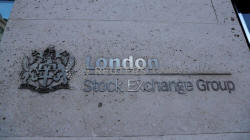Global stocks wilt as Fed shift sparks stampede into
bonds
 Send a link to a friend
Send a link to a friend
 [March 21, 2019] [March 21, 2019]
By Marc Jones
LONDON (Reuters) - European shares wilted and there was a stampede into
bonds on Thursday, after the U.S. Federal Reserve's abandonment of all
plans to raise rates this year left traders wondering what might be
lurking in the shadows.
World markets’ reaction to a super-dovish Fed was not unlike the
response to the European Central Bank’s equally easy stance earlier this
month – the benefits of a reduced interest rate horizon came laced with
doubts.
Banks suffered their usual worries about low borrowing rates to drag the
pan-European STOXX 600 down 0.2 percent, though London's FTSE edged up
as its miners were lifted by higher copper and metals prices.
The real action was in the bond markets.
With investors rushing to price in the prospect of U.S. rate cuts later
this year, benchmark Treasury yields dived to their lowest since early
2018 and those on German Bunds - Europe's benchmark - to the lowest
since October 2016.

Ten-year Bund were offering buyers virtually nothing again at just 0.048
percent interest. Alongside widespread 'curve' flattening - where
shorter and longer-term borrowing costs converge - there were alarm
bells ringing
Rabobank strategist Philip Marey said the worry is that, having cut
rates to the bone and already tried full-scale money printing, many
central banks are now low on traditionally ammunition to fight
recessions.
"The Fed has the most leeway because it has raised rates nine times so
it could cuts rates nine times," Marey said. "But it will be much more
difficult for other central banks which haven't even started to hike
yet."
The Fed's swerve had sent the dollar sliding as far as 110.47 yen, with
its 0.6 percent loss overnight the biggest drop since the flash crash of
early January.
The euro flew to a seven-week peak before things started to reverse in
Europe. It was last trading at $1.1410, a world away from its recent low
of $1.1177 while Brexit woes kept the pound down at $1.3175.
That all left the dollar at 96.100 against a basket of currencies,
having lost 0.5 percent overnight. It was also poised precariously on
its 200-day moving average, and a sustained break would be taken as
technically 'bearish'.
"The downward pressure on U.S. yields continues to support our outlook
for a weaker U.S. dollar this year," said MUFG analysts in a note.
[to top of second column] |

Signage is seen outside the entrance of the London Stock Exchange in
London, Britain. Aug 23, 2018. REUTERS/Peter Nicholls

TRADE DEAL
MSCI's broadest index of Asia-Pacific shares outside Japan was up 0.5 percent.
Chinese blue-chips, which spent the morning swinging between small losses and
gains, were up 0.4 percent in afternoon trade, while Seoul's Kospi also added
0.4 percent as regulators announced plans to cut the stock transaction tax this
year.
Australian shares ended flat after see-sawing throughout the day. A drop in the
jobless rate tempered market expectations of a rate cut.
Markets in Japan were closed for a public holiday.
Gains in the broad Asian index followed a wobbly session on Wall Street, after a
move toward risk taking sparked by the Fed's dovish shift was overtaken by
growth and trade concerns.
U.S. President Donald Trump on Wednesday warned that Washington may leave
tariffs on Chinese goods for a "substantial period" to ensure Beijing's
compliance with any trade deal.
China-U.S. trade talks are set to resume next week.
Global growth worries extended to commodity markets, where oil prices, which had
jumped Wednesday on supply concerns, retreated.
U.S. crude fell 0.1 percent to $60.17 a barrel after touching four-month highs
on Wednesday. But Brent crude regained some ground, adding 0.15 percent to
$68.60.

Weakness in oil prices is seen to be limited by efforts led by the Organization
of the Petroleum Exporting Countries (OPEC) to curb supply. Widely watched U.S.
data also showed supplies were tightening.
Gold and copper gained though on the weaker dollar, with spot gold adding about
0.5 percent to $1,318.94 per ounce. Copper rose 0.9 percent to $6,517 a tonne,
having touched a near three-week high earlier in the session.
(Additional reporting by Andrew Galbraith in Shanghai and Tommy Wilkes in
London; Editing by Raissa Kasolowsky
[© 2019 Thomson Reuters. All rights
reserved.] Copyright 2019 Reuters. All rights reserved. This material may not be published,
broadcast, rewritten or redistributed.
Thompson Reuters is solely responsible for this content. |